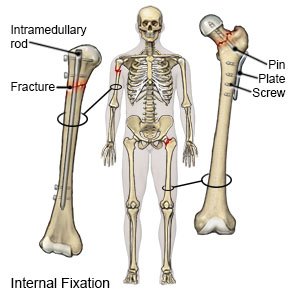ORIF of a Leg Fracture
Medically reviewed by Drugs.com. Last updated on Apr 6, 2025.
What do I need to know about open reduction and internal fixation (ORIF) of a leg fracture?
ORIF is surgery to fix a broken bone in your leg. Open reduction means the bone is put back into the correct position. Internal fixation means hardware (such as screws or plates) is used to hold the broken bone together while it heals.
 |
How do I prepare for ORIF?
- Your surgeon will tell you how to prepare for surgery. He or she may tell you not to eat or drink anything after midnight on the day of surgery. Arrange to have someone drive you home after surgery.
- Tell your surgeon about all medicines you currently take. He or she will tell you if you need to stop any medicine for surgery, and when to stop. He or she will tell you which medicines to take or not take on the day of surgery.
- Tell your surgeon about all your allergies. Tell him or her if you had an allergic reaction to anesthesia or antibiotics.
What will happen during ORIF?
- An incision will be made in the skin over your broken bone. Your surgeon will put the broken bone pieces back together. Metal pins, screws, rods, or plates will be screwed into the side of the broken bones to hold them together while they heal. Your surgeon may take some bone from your hip. The bone can be used as a graft to help fix and strengthen your broken leg.
- X-rays may be taken during surgery to help your surgeon make sure your broken bone is straight. The x-rays also tell your surgeon if the pins, plates, and screws are placed correctly. Your surgeon may put a hinge called an external fixator on the outside of your broken bone. It will be taken off when your bones have healed. The incision will be closed with stitches or medical tape. A brace or cast will be put on your leg to help hold the bones in the correct position while they heal.
What should I expect after ORIF?
You will be taken to a recovery room until you are fully awake. Healthcare providers will watch you closely for any problems. When healthcare providers see that you are okay, you will be taken to your hospital room. Do not get out of bed until your healthcare provider says it is okay.
- A brace or cast will be put on your leg after surgery.
- Thin rubber tubes may be put into your skin to drain fluid from around your incision.
- Medicines may be given to prevent or treat pain, infection, nausea, or a blood clot.
What are the risks of ORIF for a leg fracture?
After surgery, your leg may not heal correctly. The nerves or blood vessels near the bone may have been damaged when your leg was broken. You may develop a blood clot or a fat embolus (fat that blocks a blood vessel). These problems can be life-threatening.
Care Agreement
You have the right to help plan your care. Learn about your health condition and how it may be treated. Discuss treatment options with your healthcare providers to decide what care you want to receive. You always have the right to refuse treatment. The above information is an educational aid only. It is not intended as medical advice for individual conditions or treatments. Talk to your doctor, nurse or pharmacist before following any medical regimen to see if it is safe and effective for you.© Copyright Merative 2025 Information is for End User's use only and may not be sold, redistributed or otherwise used for commercial purposes.
Further information
Always consult your healthcare provider to ensure the information displayed on this page applies to your personal circumstances.
